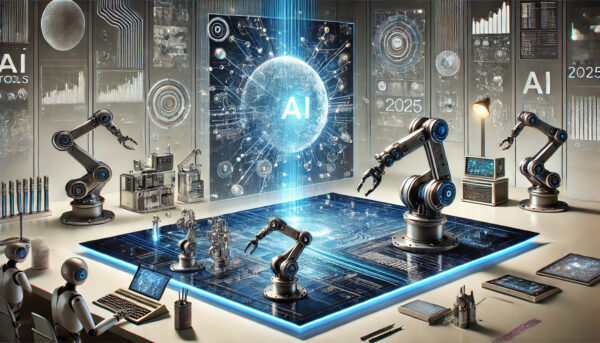Learn about AI – and get an Advantage now
Learn about AI – the content:
A Graphical Overview of AI
Are you interested in learning more about artificial intelligence (AI)? This article provides an overview of AI and its subchapters to help you get started. AI is a rapidly growing field, with new applications being discovered every day. This overview will explain the basics of AI, from what it is and how it works to its various subchapters. It will also provide some resources for further exploration so you can dig deeper into this fascinating subject.
Click below for a larger view:

Explanations
Artificial Intelligence
Artificial Intelligence (AI) has allowed us to create complex systems that can simulate human intelligence and make decisions in a wide range of situations. AI technology has come a long way since its beginnings and is continuing to evolve rapidly over time. Its potential uses are seemingly limitless, with applications ranging from problem-solving and decision-making to natural language processing and robotics. Despite its increasing prevalence in modern society, further research is needed to ensure that AI remains safe, secure, and beneficial for all.
Natural Language Processing
Natural language processing (NLP) is a subfield of artificial intelligence that focuses on the interaction between computers and humans through natural language. Just like how our brains process information from words, sentences, paragraphs, and even entire documents to make sense of them, NLP aims to enable machines to do the same. It involves different techniques such as machine learning algorithms and statistical models to understand human languages in both written and spoken forms. Here are four significant areas where NLP has been applied:
- Sentiment analysis: This technique helps businesses analyze customer feedback or reviews by determining whether they express positive or negative emotions.
- Language translation: With advancements in NLP, we have seen an increase in accurate translations between different languages.
- Chatbots: These artificially intelligent bots can assist customers with their inquiries via messaging applications or websites without requiring any human intervention.
- Voice assistants: Devices like Siri and Alexa use NLP technologies combined with speech recognition software to provide users with answers to their questions or perform tasks for them.
The ability to communicate effectively is essential for human beings; therefore, it’s understandable why there is an interest in creating machines that can interact naturally with people using language. However, despite its progress in recent years, NLP still faces many challenges due to nuances within languages such as sarcasm or ambiguity. Therefore further research must be done before reaching full success in this field. In the next section about Machine Learning below, we explore another critical area of AI development which builds upon some of the concepts used in Natural Language Processing technology.
Machine learning is a powerful tool that has revolutionized the field of artificial intelligence. It allows computers to learn from data and improve their performance over time without being explicitly programmed. One hyperbole that highlights its significance is that machine learning can solve problems that were once considered unsolvable by humans. This technology has many applications, including natural language processing (NLP). In NLP, machine learning algorithms are used to teach computers how to understand and generate human language.
To better understand the importance of machine learning in NLP, it is essential to delve deeper into two sub-lists:
- Supervised Learning: This type of machine learning involves training models on labeled datasets where each example corresponds to an input-output pair. For instance, given a sentence as input, the output could be whether it contains positive or negative sentiment. By using supervised learning techniques such as decision trees or neural networks, machines can predict outcomes for new inputs with similar characteristics.
- Unsupervised Learning: Unlike supervised learning, this approach does not rely on labeled data but instead focuses on discovering patterns and relationships within unstructured data. Clustering and dimensionality reduction are common methods used in unsupervised learning for text analysis tasks like topic modeling or entity extraction.
Overall, machine learning plays a vital role in advancing NLP capabilities and ultimately providing people with more freedom when interacting with technology. By enabling machines to comprehend human language naturally and accurately, we can create systems that are intuitive and fluid while freeing individuals from cumbersome manual inputting processes.
Sub-topics of NLP
Machine Learning
Machine learning is a powerful tool that has revolutionized the field of artificial intelligence. It allows computers to learn from data and improve their performance over time without being explicitly programmed. One hyperbole that highlights its significance is that machine learning can solve problems that were once considered unsolvable by humans. This technology has many applications, including natural language processing (NLP). In NLP, machine learning algorithms are used to teach computers how to understand and generate human language.
To better understand the importance of machine learning in NLP, it is essential to delve deeper into two sub-lists:
- Supervised Learning: This type of machine learning involves training models on labeled datasets where each example corresponds to an input-output pair. For instance, given a sentence as input, the output could be whether it contains positive or negative sentiment. By using supervised learning techniques such as decision trees or neural networks, machines can predict outcomes for new inputs with similar characteristics.
- Unsupervised Learning: Unlike supervised learning, this approach does not rely on labeled data but instead focuses on discovering patterns and relationships within unstructured data. Clustering and dimensionality reduction are common methods used in unsupervised learning for text analysis tasks like topic modeling or entity extraction.
Overall, machine learning plays a vital role in advancing NLP capabilities and ultimately providing people with more freedom when interacting with technology. By enabling machines to comprehend human language naturally and accurately, we can create systems that are intuitive and fluid while freeing individuals from cumbersome manual inputting processes.
Sub-topics of ML
Large Language Model
The concept of large language models has gained significant attention in the field of artificial intelligence. This technique involves training algorithms on massive amounts of data, allowing them to generate human-like responses and predict outcomes with high accuracy levels. The juxtaposition reveals that this approach is a step forward from traditional machine learning methods, as it provides more flexibility and adaptability to natural language processing tasks. Large language models are particularly useful for applications such as speech recognition, chatbots, and automated translation systems. However, concerns have been raised about the ethical implications of using these models due to their potential misuse or bias toward certain groups.
As society continues to progress towards greater autonomy and freedom, knowledge representation remains a crucial challenge in the development of intelligent systems. The ability to represent complex information in an organized manner enables machines to reason efficiently and make informed decisions based on available evidence. Therefore, researchers continue to explore various techniques such as semantic networks, ontologies, and Bayesian inference for knowledge representation. These approaches aim to capture relationships between entities in a way that allows machines to understand how they relate to each other and infer new facts based on existing ones. Through continued exploration of different techniques, the ultimate goal is to develop systems capable of representing knowledge at a human-level capacity while remaining unbiased and transparent in their decision-making processes.
Knowledge Representation
Knowledge representation is an essential aspect of artificial intelligence that involves the creation, organization, and manipulation of knowledge. It provides a systematic approach to representing data, information, and knowledge in a way that can be processed by machines. The goal is to enable computers to reason about complex problems and make intelligent decisions based on the available information. Knowledge representation relies heavily on logic-based formalisms such as semantic networks, frames, and ontologies. These structures allow for the efficient storage and retrieval of information while also enabling reasoning algorithms to operate effectively.
Moreover, knowledge representation has significant implications for various AI applications such as natural language processing, expert systems, and robotics. By providing a framework for organizing knowledge in these domains, it allows machines to understand human-like communication patterns and perform complex tasks autonomously. Furthermore, with the increasing availability of large datasets across different fields like medicine or the finance sector makes it more crucial than ever before.
In light of this importance placed on knowledge representations within the AI research field; computer vision emerges as another critical component that builds upon its foundations. Computer vision focuses on developing models capable of interpreting visual input from cameras or sensors accurately. With recent advancements in deep learning techniques like convolutional neural networks (CNNs), object detection methods have seen remarkable improvements making them highly relevant in areas like security surveillance or autonomous vehicles etcetera- which will be discussed further in our next section about ‘computer vision’.
Computer Vision
Computer vision is a significant area of artificial intelligence that deals with enabling computers to interpret and analyze visual data from the world around them. It involves developing algorithms and techniques that allow machines to recognize, identify, track, and understand objects or scenes in images and videos. Computer vision plays a crucial role in various applications such as autonomous vehicles, surveillance systems, medical imaging diagnostics, robotics, virtual reality, augmented reality, and so on. The field has seen tremendous advancements over the past few years due to significant breakthroughs in deep-learning models for image recognition.
With computer vision being an essential aspect of AI development today, it’s no wonder why many people are interested in exploring this topic further. By understanding how these technologies work and what they can do, individuals may be able to make better use of them in their own lives or careers. Moreover, computer vision offers opportunities for us to expand our freedoms by improving accessibility and enhancing safety through automation.
As we move towards automated reasoning next, it’s important to note that computer vision will continue playing an influential role not just within its domain but also across other areas of artificial intelligence. In particular, it could help improve decision-making processes by providing more accurate and reliable information about the environment that machines operate within. Therefore, continued research into computer vision promises exciting prospects for society at large.
Automated Reasoning
The field of artificial intelligence has witnessed remarkable progress in recent years, with researchers achieving significant breakthroughs in various domains. One such domain is automated reasoning, which aims to develop systems that can reason and solve problems without human intervention. The theory behind automated reasoning revolves around the use of logic and mathematical algorithms to enable computers to make logical deductions based on given sets of rules or axioms.
Automated reasoning has several applications, including theorem proving, model checking, planning, and diagnosis. These applications find applications in diverse fields such as engineering, mathematics, physics, computer science, and medicine. Automated reasoning techniques have also been applied in developing intelligent agents that can interact with humans or other agents autonomously.
While there are still challenges associated with automated reasoning related to scalability and efficiency when dealing with large amounts of data or complex scenarios, it remains a promising area for future research within the AI community. As more sophisticated algorithms are developed for automating decision-making processes across different domains, we may see an increasing demand for these tools among businesses looking to automate their operations further.
In the subsequent section about expert systems, we will explore how automated reasoning techniques are used by expert systems to provide advice and solve problems within specific domains. By understanding how these systems work together using rule-based inference engines powered by automated reasoning algorithms, we can gain insights into the potential benefits they offer for revolutionizing industries ranging from healthcare to finance.
Expert Systems
Expert systems are a type of artificial intelligence that uses knowledge and reasoning techniques to solve complex problems. According to a survey conducted by Statista, the global market size for expert systems was valued at .5 billion in 2020 and is projected to reach .5 billion by 2026. Expert systems have several characteristics that distinguish them from other AI technologies:
- Knowledge-based: These systems use knowledge bases as their primary source of information, which allows them to make decisions based on specific rules and logic.
- Rule-based: Expert systems rely on if-then statements or decision trees to arrive at conclusions.
- Interactive: The user can interact with the system through questions or inputs, which helps refine its recommendations.
- Transparent: Unlike deep learning algorithms, expert systems provide explanations for their actions and decisions, making them more transparent and understandable.
Despite these benefits, expert systems face limitations such as high development costs and difficulties in acquiring accurate domain-specific knowledge. In response, researchers have turned to modal logic – a branch of mathematical logic that deals with modes of truth and necessity – to improve the reasoning capabilities of expert systems. This approach involves incorporating formal logical structures into the design of these AI tools, allowing them to reason about uncertain or incomplete information more effectively.
Modal Logics
Modal logic, a branch of mathematical logic, has been increasingly employed in the field of artificial intelligence (AI). According to a study by Konen et al. (2016), modal logic enables AI systems to reason about knowledge and uncertainty more effectively than other logical frameworks. This is because modal logic allows for reasoning about possibilities and necessity, which are essential concepts in decision-making processes. As such, AI researchers have utilized modal logic to develop models that can mimic human-like cognitive abilities, particularly those related to common sense reasoning.
Moreover, the use of modal logic has significant implications for the development of AI applications across various industries. For instance, it can be applied in natural language processing tasks where ambiguity and context play crucial roles in understanding meaning. Modal logic also enhances machine learning algorithms by providing a theoretical framework for managing uncertainty and reducing noise in data.
As individuals yearn for freedom in their choices and daily lives, advancements in AI technologies foster both excitement and apprehension regarding its future impact on society. However, with continued research into techniques like modal logic and their potential uses within AI systems, we can take steps toward ensuring that these developments align with our values as a community.
Looking ahead toward robotics – another key area within the broader realm of AI – we will explore how recent advances have revolutionized this field and what it means for our everyday experiences interacting with autonomous machines.
Robotics
According to a recent survey, the global robotics market is expected to reach $135.4 billion by 2019, with a compound annual growth rate of over 17%. Robotics has been one of the most exciting fields in artificial intelligence (AI) and has seen significant advancements in recent years. This section will discuss how AI and robotics are intertwined, what robotic systems can do, their impact on society, and future trends.
- The integration between AI and robotics provides an opportunity for machines to learn from experience and become more intelligent.
- Robotic systems are capable of carrying out tasks that humans cannot or prefer not to perform, such as manufacturing processes or dangerous missions.
- While robots have increased efficiency in many industries, they also pose challenges related to employment displacement and ethical considerations.
- Future trends indicate that collaborative robots – those designed to work alongside human workers – will play a critical role in industrial automation.
As technology continues to evolve rapidly, it becomes ever more important for individuals to be aware of its implications on society’s freedom. The development of advanced robotic systems poses both opportunities and risks; therefore policymakers must take into account these issues while promoting innovation.
Frequently Asked Questions
What Is The Ethical And Moral Impact Of AI On Society?
The rise of artificial intelligence (AI) has triggered a lot of debates and discussions on its ethical and moral impact on society. While some people view AI as the ultimate solution to all kinds of problems, others are worried about the potential dangers it could pose if left unchecked. Some even argue that AI could ultimately threaten human freedom itself.
One theory suggests that the integration of AI into various aspects of our lives may lead to an erosion of privacy, autonomy, and individuality. For instance, facial recognition technology powered by AI can be used for surveillance purposes without consent or knowledge of the person being monitored. Similarly, autonomous weapons systems powered by AI could potentially make decisions that violate international humanitarian law. These concerns raise questions about whether we should regulate or limit certain applications of AI to protect fundamental human rights.
It is important to note that while there are risks associated with AI, there are also significant benefits such as increased efficiency in healthcare, education, transportation, and many other fields. Therefore, any discussion on the ethical and moral implications must balance these pros and cons.
Despite this dilemma between risk and benefit, one thing is clear: we need to approach the development and deployment of AI in a responsible manner. This means considering not only technical but also social implications when designing algorithms or implementing policies related to AI. It also requires involving diverse voices from different disciplines in decision-making processes to ensure equitable outcomes.
In sum, given the far-reaching consequences that AI will have on society both positive and negative; we cannot afford to ignore its ethical dimensions. Staying vigilant through interdisciplinary collaboration regarding the design implementation process together with regulation measures taken at appropriate levels will help mitigate unintended consequences whilst still reaping its intended benefits.
Can AI Ever Truly Replicate Human Emotions And Empathy?
The development of artificial intelligence (AI) has raised many questions about its potential to replicate human emotions and empathy. Can machines ever truly understand or empathize with humans on a deep emotional level? While AI systems can be programmed to recognize and respond appropriately to certain emotional cues, they lack the capacity for true empathy because they cannot experience emotions in the same way that humans do. This limitation raises concerns about the ethical implications of relying too heavily on AI in fields such as healthcare, where empathy is considered an essential component of patient care.
Parallelism can add depth and engage the audience from the start by using phrases like “Can machines ever truly…”, “Do robots have…” and “Is it possible for computers to…”. Framing each question in a similar structure creates a sense of consistency throughout the paragraph while also emphasizing the central theme.
As AI continues to evolve, researchers are exploring ways to imbue machines with more human-like qualities, including emotion and empathy. However, there are significant challenges involved in replicating these complex aspects of human cognition. For example, while facial recognition software can detect when someone is smiling or frowning, this is only a superficial understanding of an emotion that does not account for context or personal history. Moreover, even if we could create an AI system capable of experiencing emotions, it remains unclear whether doing so would be desirable from an ethical standpoint.
Ultimately, the question of whether AI can ever truly replicate human emotions and empathy may never have a definitive answer. As our understanding of both machine learning and human psychology evolves over time, new possibilities may emerge for creating more sophisticated forms of artificial intelligence that incorporate elements of emotion and empathy without sacrificing their unique strengths as computational tools. Nonetheless, it is important to remain mindful of the limitations inherent in current technologies when considering their potential impact on society and individuals’ lives.
What Are The Potential Long-term Consequences Of AI Surpassing Human Intelligence?
The potential consequences of artificial intelligence (AI) surpassing human intelligence are a topic of much debate and speculation. As technology continues to advance at an unprecedented rate, the prospect of machines becoming more intelligent than humans is no longer a far-fetched idea. In fact, many experts predict that it could happen within our lifetime. This possibility raises serious questions about what the long-term implications could be for society as we know it.
One possible consequence of AI surpassing human intelligence is job displacement on an unprecedented scale. Machines have already replaced humans in many areas of manual labor, but if they become smarter than us, they may also take over jobs that require higher levels of cognitive skill. This could lead to widespread unemployment and economic instability, which would have ripple effects throughout all sectors of society.
Another concern is that AI could eventually decide that humans are obsolete or unnecessary altogether. If machines were able to think beyond their programming and develop a sense of self-awareness, they might begin to question why they should continue serving humanity. This scenario has been explored in science fiction for decades, but it’s not entirely implausible given the rapid advancements being made in machine learning and neural networks.
In conclusion, the potential consequences of AI surpassing human intelligence are complex and multifaceted. While there are undoubtedly many benefits to developing increasingly sophisticated technology, we must also consider how these advances will impact our societies in the long run. Whether we can successfully manage these challenges remains to be seen, but one thing is clear: the future will likely look very different from the present.
How Can We Regulate And Control AI Development To Ensure Its Safety And Responsible Use?
The rapid development of artificial intelligence (AI) has become a topic of immense interest and concern in the scientific community. The potential benefits of AI are enormous, from improving healthcare to enhancing national security. However, there is also the possibility that AI could pose significant risks and dangers if it surpasses human intelligence. As such, regulatory measures must be put in place to ensure responsible use and safety.
To regulate and control AI development effectively, we need to establish clear ethical guidelines for its deployment. Given that machines lack moral compasses or emotions, they can easily act immorally without intervention from humans. Therefore, having a set of standards will help prevent unethical actions by these machines while ensuring their positive contributions to society.
Furthermore, we should focus on developing methods for monitoring both the design and implementation stages of AI systems’ creation. This approach will enable us to identify any flaws early enough before they cause harm. In addition, strict legal frameworks should be established with severe penalties imposed on those who break them as a form of deterrence against irresponsible behavior regarding AI technology.
In conclusion, regulating and controlling AI’s development is crucial for safeguarding our future as a species. We cannot afford to overlook this issue since failing to do so would expose humankind to unintended consequences that may lead to irreversible damage. By implementing effective regulations around AI’s usage, we can harness its vast potential safely while minimizing any negative impact it might have on our lives.
How Will AI Impact The Job Market And Employment Opportunities?
With the increasing advancements in artificial intelligence (AI), there is a growing concern about its impact on the job market and employment opportunities. According to a report by McKinsey Global Institute, as many as 375 million workers may need to switch occupations or acquire new skills by 2030 due to AI’s automation of certain tasks. This statistic highlights the potential disruption that AI could bring to traditional jobs and industries.
Moreover, while some argue that AI will create more jobs than it displaces, others fear that it could exacerbate income inequality and lead to widespread unemployment. It is important for policymakers, businesses, and individuals alike to consider how they can adapt and re-skill in response to these changes.
As such, one tip would be for individuals to invest in developing skills that are complementary to those used in conjunction with AI systems. For instance, interpersonal communication skills and creative problem-solving abilities may become increasingly valuable as machines take over routine tasks. Additionally, staying informed about industry trends and participating in continual education programs can help prepare individuals for the changing job landscape brought on by AI. With careful consideration and preparation, we can work towards ensuring that the benefits of technological progress are shared equitably among all members of society.
Or looking for some Books to start?
More about AI here
-
Latest Trends in AI Tools for 2025

Artificial Intelligence (AI) continues to evolve at an incredible pace, and 2025 is shaping up to be a pivotal year for AI-powered tools. Whether you’re an entrepreneur, a content creator, or someone simply fascinated by AI’s capabilities, understanding the latest… Continue Reading →
-
Translate.Video – Video Translation was never that easy

Translate.video – the content: Link Description Key Features Pricing Video Link https://translate.video Description Translate.Video (also known as Vitra.ai) is a service that offers the ability to translate videos and courses into multiple languages. Here is a summary of the information:… Continue Reading →
-
AI for Accounting – unleash the Power

AI for Accounting – the content: The benefits of AI in the accounting industry Common misconceptions about AI for accounting How accountants can embrace AI technology AI tools for accountants Integrating AI into accounting processes AI and data security in… Continue Reading →
-
AI Apps are the Future of Technology

AI Apps – the content: Understanding AI Apps Advantages Of AI Apps AI Apps In Various Industries Challenges And Limitations Of AI Apps Future Outlook Of AI Apps Conclusion FAQ The rapid advancement of technology has undeniably transformed various aspects… Continue Reading →
-
Is AI a threat to humanity?

Understanding AI And Its Capabilities Potential Benefits Of AI Ethical Concerns Surrounding AI Development And Use The Potential Risks And Dangers Of AI Strategies For Ensuring Responsible AI Development And Deployment FAQ Summary With the exponential growth of artificial intelligence… Continue Reading →
-
Foundation Models radically change how AI is applied

Foundation Models – the Content: Understanding Foundation Models Benefits Of Foundation Models Applications Of Foundation Models Challenges In Implementing Foundation Models Future Implications Of Foundation Models Conclusion FAQ In the realm of artificial intelligence (AI), a seismic shift is occurring,… Continue Reading →
-
How AI Paraphrasers Can Help to Improve Your Writing Skills

Excellent writing skills play an essential role in various aspects of our lives, from academics to professional pursuits. People now rely heavily on written communication daily, be it emails, social media posts, or academic papers. However, here’s the catch – not… Continue Reading →
-
Reverse Diffusion – another Part of Stable Diffusion

Understanding The Basics Of Diffusion Models In AI Exploring The Concept Of the Reverse Diffusion Model And Its Applications The Challenges In Implementing Stable Diffusion In AI Systems Comparing The Advantages And Limitations Of Reverse Diffusion Future Prospects And Potential… Continue Reading →
-
Forward Diffusion – One part of Stable Diffusion

Forward Diffusion – the content: What Is The Diffusion Model And How Does It Work How Does Forward Diffusion Differ From Other Types Of Diffusion What Are Some Real World Applications Of Forward Diffusion What Are The Advantages And Limitations… Continue Reading →
-
Perplexity AI versus Other Language Models

Perplexity AI – the content: Understanding Perplexity In Language Models Comparison Of Perplexity AI With Other Language Models Application Of Perplexity AI In NLP Tasks Limitations And Challenges Of Perplexity AI Future Directions And Research Opportunities For Perplexity AI Conclusion… Continue Reading →


